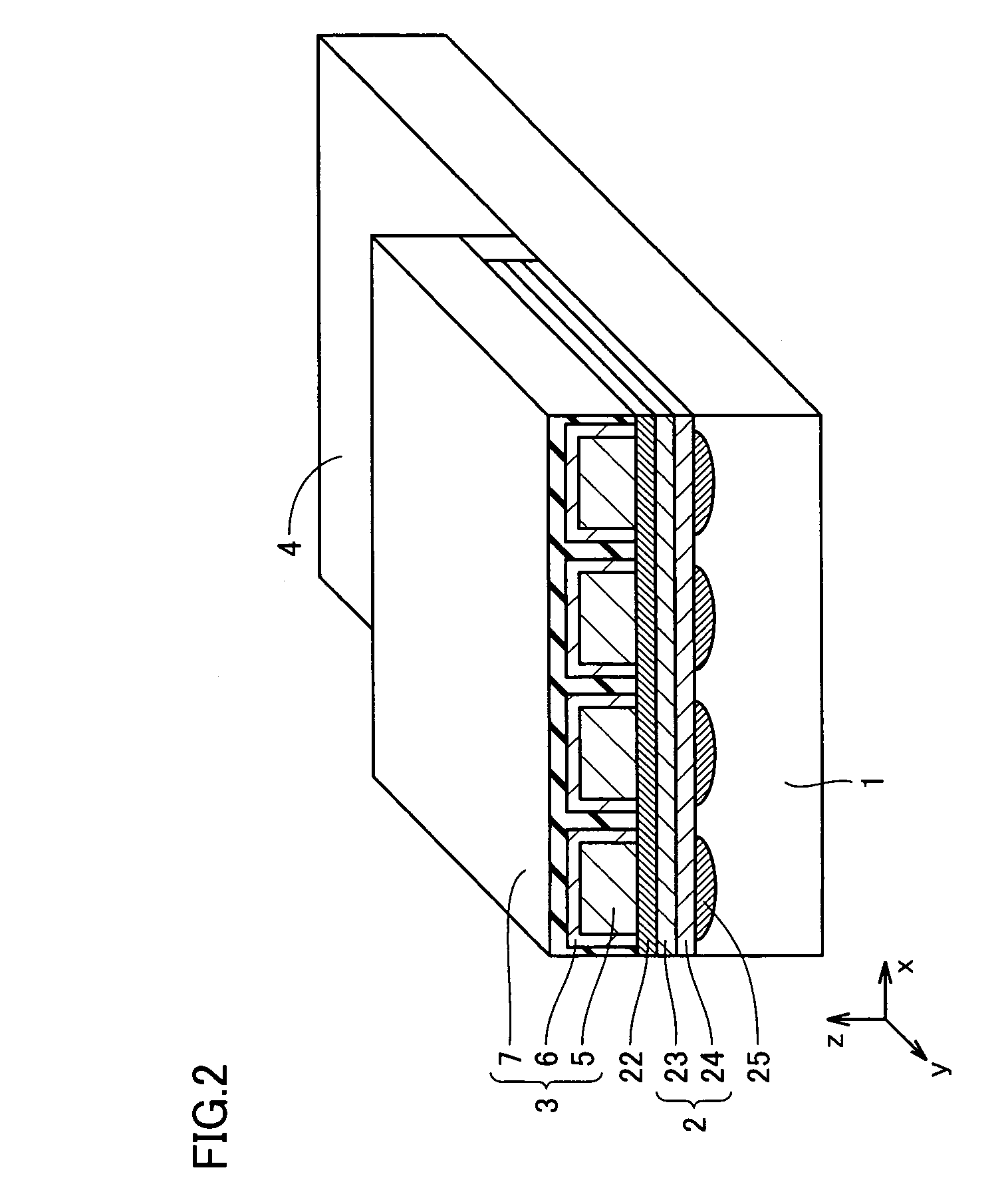Exposure device and image forming device
a technology of image forming device and exposure device, which is applied in the direction of instruments, optical elements, recording devices, etc., can solve the problems of high material cost, difficult to reduce cost, and difficult to produce lsus of smaller size and adaptability, and achieve the effect of small and inexpensiv
- Summary
- Abstract
- Description
- Claims
- Application Information
AI Technical Summary
Benefits of technology
Problems solved by technology
Method used
Image
Examples
first embodiment
[0040](First Embodiment)
[0041]FIG. 1 shows a schematic cross sectional view of the structure of one exemplary exposure device with an anode provided on a single-crystal silicon substrate 1. The substrate is shown being made of single-crystal silicon as one example. Referring to FIG. 1, the exposure device is provided with a driver circuit portion 4 including drive circuitry, an anode 12, a hole transporting layer 13, an electron transporting and emitting layer 14, a cathode 15, an optical waveguide core layer 5, an optical waveguide clad layer 6, and a shading wall 7. Of the xyz coordinates in FIG. 1, the direction z is the direction of deposition of the layers and the direction y is the direction of edge emission, and an edge emitting structure is employed where an organic EL emissive element 2 emits light in the edge direction (direction y) perpendicular to the direction of deposition of the electrode layers and organic compound layers (direction z).
[0042]FIG. 2 shows a schematic ...
second embodiment
[0090](Second Embodiment)
[0091]Turning to FIG. 3, an exposure device according to a second embodiment will be described. The prerequisites for a structure as shown in FIGS. 1 and 2 are that the amount of light propagated along optical waveguide layer 3 is sufficiently larger than the amount of light propagated along organic EL emissive element 2 and that the crosstalk of light in organic EL emissive element 2 is negligible. However, constraints due to the material, such as refractive index, or those due to the structure, such as film thickness, may cause the amount of light propagated along organic EL emissive element 2 to be relatively large. Then, crosstalk of light in organic EL emissive element 2 becomes a problem. Specifically, light emitted from an element adjacent to a non-emissive element is propagated to the non-emissive region so that light is emitted from an edge of the non-emissive region. Crosstalk in the exposure head forms an image in a location that should be a non-i...
third embodiment
[0093](Third Embodiment)
[0094]Turning to FIG. 4, an exposure device according to a third embodiment will be described. Constructing an exposure device as shown in FIG. 4 can improve the efficiency in light propagation in organic EL emissive element 2 without optical waveguide layer 3.
[0095]The organic compound layers have a three-layer structure with an emitting layer with a refractive index of n4 and sandwiching layers with a refractive index of n5 for sandwiching the emitting layer and having an electron transporting material and a hole transporting material mixed together, where the refractive index of the emitting layer, n4, and the refractive index of the sandwiching layers, n5, satisfy the relationship of n4>n5, and a shading wall that is non-transmissive to light and light-absorbing is provided between adjacent ones of the organic EL emissive elements.
[0096]For example, when organic EL emissive element 2 has a three-layer structure as shown in FIG. 4, organic EL emissive elem...
PUM
 Login to View More
Login to View More Abstract
Description
Claims
Application Information
 Login to View More
Login to View More - R&D
- Intellectual Property
- Life Sciences
- Materials
- Tech Scout
- Unparalleled Data Quality
- Higher Quality Content
- 60% Fewer Hallucinations
Browse by: Latest US Patents, China's latest patents, Technical Efficacy Thesaurus, Application Domain, Technology Topic, Popular Technical Reports.
© 2025 PatSnap. All rights reserved.Legal|Privacy policy|Modern Slavery Act Transparency Statement|Sitemap|About US| Contact US: help@patsnap.com



